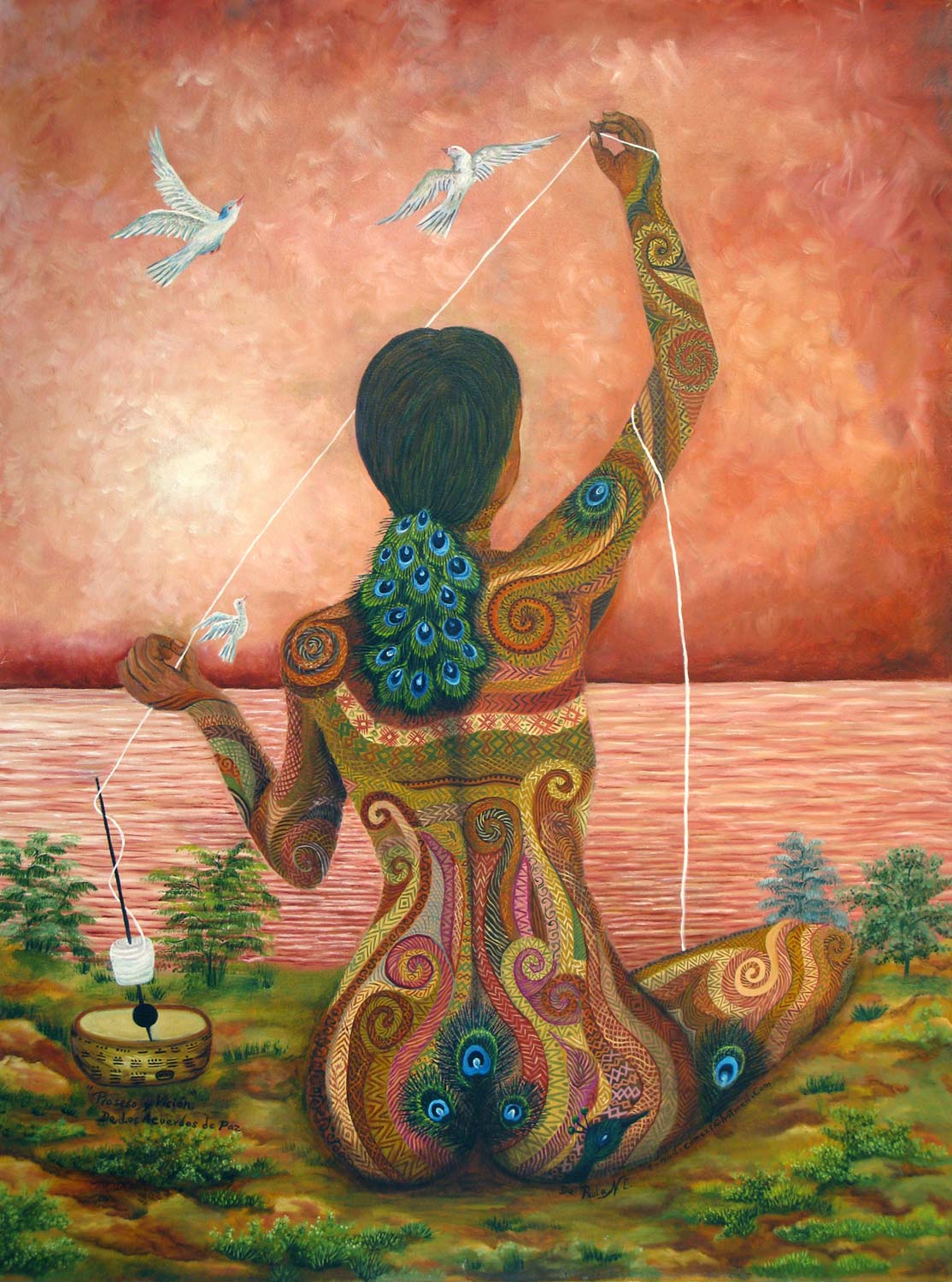The title of this alluring painting alludes to a dark past and the hope for a better future. Paula Nicho Cúmez describes this painting: “To me, Guatemala has been drowned, as in the sea. I feel that the only thing that remains for us is to once again weave the country, without forgetting our histories, which we carry in our skin and in our voices.” The signing of the Peace Accords in December of 1996 marked the end of a long period—starting with Pedro Alvarado in 1523—of subjugation, discrimination, and genocide against the Maya people and the beginning of a new chapter in Guatemala with protections for the indigenous communities.
The events that led to genocide by the Guatemalan military and the deaths of 200,000 Maya in the 1970s and 1980s started in 1954 with the overthrow of the democratically elected President Jacobo Árbenz in a coup sponsored by the U. S. Central Intelligence Agency (CIA). Árbenz backed agrarian reform, but international companies such as United Fruit used their influence to get the United States to secretly back a coup. The government required Maya men to work on plantations for several months every year while being paid less than one dollar a day. The coup put an end to land reform, but some of the Maya campesinos, justifiably dissatisfied, began guerilla actions against some of plantation owners. As the conflicts grew, the United States labeled the rebels as communists, and brought Guatemala military leaders to the United States to train them in counter-guerrilla warfare. This training of the military led to the atrocities against Maya people and communities. A turning point in this conflict took place in 1993 when the Guatemalan military massacred thirteen protesters in the town of Santiago Atitlán, a popular tourist destination. This event caused an international furor. The Guatemalan military for the first time backed down. The United Nations initiated peace negotiations that resulted in was the Peace Accords, signed in 1996.
Paula Nicho Cúmez’s painting depicts a weaver spinning the thread she will use to weave fabric. Nicho Cúmez’s paintings always contain symbolism. Here the thread could refer to the Peace Accords, and the fabric then might be the result of the Accords. Among its many provisions, the Guatemalan Peace Accords contain an “Agreement on Identity and Rights of Indigenous Peoples.” It states that the Maya world view is “based on the harmonious relationship of all elements of the universe, in which the human being is only one additional element, in which the earth is the mother who gives life and maize is a sacred symbol around which Maya culture revolves.” For the Maya, the provisions on indigenous rights and identity are the basis on which to start being accepted on an equal basis.
An underlying theme in all of Paula Nicho Cúmez’s paintings is her outlook as a Maya and as a woman. The Peace Accords have provisions to eradicate discrimination against indigenous people and especially against women. It further states that Guatemalan culture is based on Maya culture and that all the Mayan languages deserve official status, equal respect, and inclusion in the educational system. In the painting, the skin of the weaver is covered with peacock feathers. Paula refers to her traditional attire as her second skin. She says she would feel naked if she did not wear this attire. The Accords affirm the right of the Maya to wear their traditional attire under all circumstances. Paula’s hand-woven huipil (blouse) and corte (skirt) identify her as a Maya from the town of San Juan Comalapa.
One of the elements of the Accords grant the Maya the right to openly practice traditional Maya spirituality. The Accords recognize the “special nature of Maya spirituality as an essential component of the Maya vision of the world.” This recognition had an immediate effect. The Ajq’ijab’ (Maya spiritual guides) openly began practicing their spirituality. The Accords mentioned the Maya archeological sites as an important part of Guatemala’s heritage; stated that the Maya should be able to practice their spirituality at these sites; and went on to say that all Maya holy places should be preserved.
Another effect of the Accords was significantly broadening access to communications and media for Maya communities. There now are television channels in each town with programs in the Maya languages covering subjects from local festivals to town politics. Unfortunately, even with such significant advances, the Peace Accords could not in themselves hope to completely rectify a corrupt government, or racism in the hearts of some citizens. The Accords made significant progress in elevating respect for and rights of the Maya. Many groups and individuals continue struggling to fulfill the promise of the Peace Accords.


